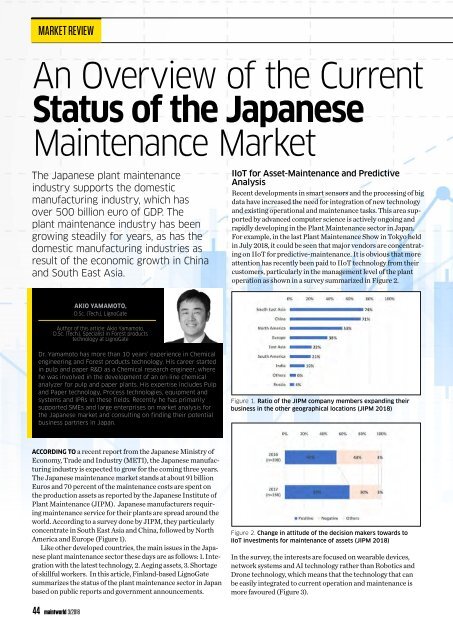Maintworld 3/2018
Are You Overlooking a Significant Source of Savings? // Advantages of broadband ultrasonic analysis // Are you in the “circle of despair”? // Future of work
Are You Overlooking a Significant Source
of Savings? // Advantages of broadband ultrasonic analysis // Are you in the “circle of despair”? // Future of work
Create successful ePaper yourself
Turn your PDF publications into a flip-book with our unique Google optimized e-Paper software.
Market review<br />
An Overview of the Current<br />
Status of the Japanese<br />
Maintenance Market<br />
The Japanese plant maintenance<br />
industry supports the domestic<br />
manufacturing industry, which has<br />
over 500 billion euro of GDP. The<br />
plant maintenance industry has been<br />
growing steadily for years, as has the<br />
domestic manufacturing industries as<br />
result of the economic growth in China<br />
and South East Asia.<br />
IIoT for Asset-Maintenance and Predictive<br />
Analysis<br />
Recent developments in smart sensors and the processing of big<br />
data have increased the need for integration of new technology<br />
and existing operational and maintenance tasks. This area supported<br />
by advanced computer science is actively ongoing and<br />
rapidly developing in the Plant Maintenance sector in Japan.<br />
For example, in the last Plant Maintenance Show in Tokyo held<br />
in July <strong>2018</strong>, it could be seen that major vendors are concentrating<br />
on IIoT for predictive-maintenance. It is obvious that more<br />
attention has recently been paid to IIoT technology from their<br />
customers, particularly in the management level of the plant<br />
operation as shown in a survey summarized in Figure 2.<br />
Akio Yamamoto,<br />
D.Sc. (Tech.), LignoGate<br />
Author of this article: Akio Yamamoto,<br />
D.Sc. (Tech.), Specialist in Forest products<br />
technology at LignoGate<br />
Dr. Yamamoto has more than 10 years’ experience in Chemical<br />
engineering and Forest products technology. His career started<br />
in pulp and paper R&D as a Chemical research engineer, where<br />
he was involved in the development of an on-line chemical<br />
analyzer for pulp and paper plants. His expertise includes Pulp<br />
and Paper technology, Process technologies, equipment and<br />
systems and IPRs in these fields. Recently he has primarily<br />
supported SMEs and large enterprises on market analysis for<br />
the Japanese market and consulting on finding their potential<br />
business partners in Japan.<br />
Figure 1. Ratio of the JIPM company members expanding their<br />
business in the other geographical locations (JIPM <strong>2018</strong>)<br />
According to a recent report from the Japanese Ministry of<br />
Economy, Trade and Industry (METI), the Japanese manufacturing<br />
industry is expected to grow for the coming three years.<br />
The Japanese maintenance market stands at about 91 billion<br />
Euros and 70 percent of the maintenance costs are spent on<br />
the production assets as reported by the Japanese Institute of<br />
Plant Maintenance (JIPM). Japanese manufacturers requiring<br />
maintenance service for their plants are spread around the<br />
world. According to a survey done by JIPM, they particularly<br />
concentrate in South East Asia and China, followed by North<br />
America and Europe (Figure 1).<br />
Like other developed countries, the main issues in the Japanese<br />
plant maintenance sector these days are as follows: 1. Integration<br />
with the latest technology, 2. Aeging assets, 3. Shortage<br />
of skillful workers. In this article, Finland-based LignoGate<br />
summarizes the status of the plant maintenance sector in Japan<br />
based on public reports and government announcements.<br />
Figure 2. Change in attitude of the decision makers towards to<br />
IIoT investments for maintenance of assets (JIPM <strong>2018</strong>)<br />
In the survey, the interests are focused on wearable devices,<br />
network systems and AI technology rather than Robotics and<br />
Drone technology, which means that the technology that can<br />
be easily integrated to current operation and maintenance is<br />
more favoured (Figure 3).<br />
44 maintworld 3/<strong>2018</strong>

















